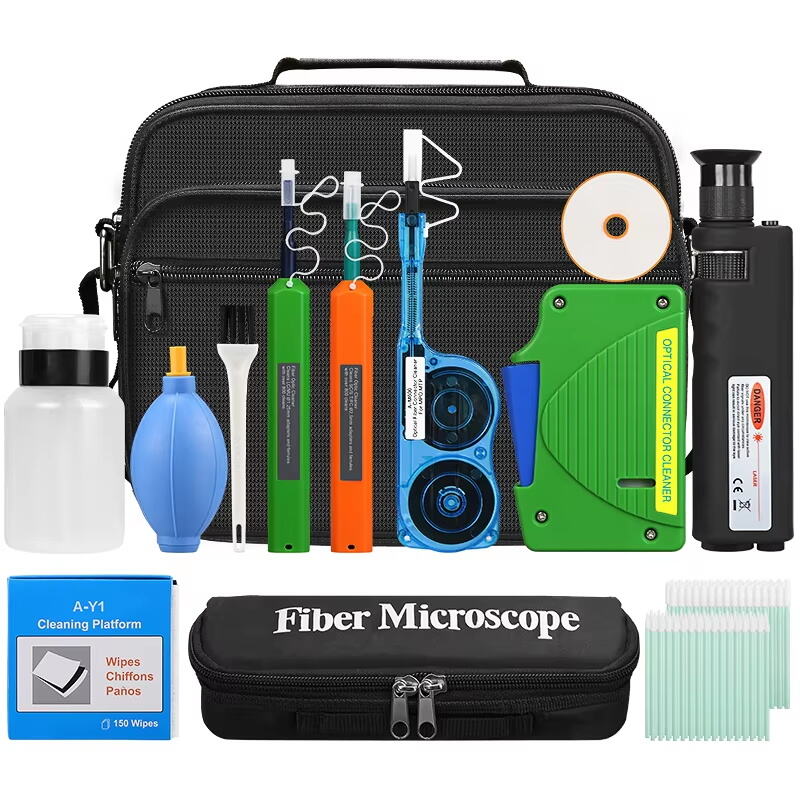Importance of Proper Fiber Optic Cleaning for Optimal Performance
Impact of Contamination on Signal Integrity
Dust and debris accumulating on fiber optic connections really messes with how well signals travel through them. When these tiny particles get stuck there, they either soak up the light or bounce it around, which makes the signal weaker and slows down data moving across the network. Telecom professionals have found that something as small as a 1 micrometer speck landing on a connector can actually cut signal quality by about 12 percent. This kind of dirt buildup doesn't just slow things down; it can also create problems for important systems where consistent performance matters most. That's why keeping those connectors clean remains so important for anyone wanting their fiber optic network to maintain good speeds and reliable data transfers without constant interruptions.
Costly Downtime Caused by Poor Cleaning Practices
When companies skip on proper cleaning for their fiber optic equipment, they're basically setting themselves up for expensive downtime. According to some industry numbers we've seen, dirty fiber optics can actually cost businesses around $5,600 every single minute they're down. Take one major data center as an example they had a serious network crash that lasted nearly three whole hours. The fallout? Millions lost due to service disruptions plus all the money spent fixing things afterward. Regular cleaning and maintenance routines aren't just good ideas they save money in the long run by keeping networks running smoothly and avoiding those surprise blackouts. Most smart IT managers schedule these cleanings right alongside other essential maintenance tasks, which helps keep operations stable and reduces those nasty unplanned expenses that nobody wants to deal with.
Core Components of a Fiber Optic Cleaning Kit
Lint-Free Wipes and Swabs: Safe Surface Cleaning
Lint free wipes and swabs play a key role when it comes to safely cleaning fiber optic surfaces. The main reason? These materials won't leave behind annoying fibers or residue that could mess with optical signals. There's actually quite a range of options available depending on what needs cleaning. Foam swabs work great for those tricky details, whereas bigger wipes handle wider areas much better. When picking out products, connector size and design matter a lot too. Going with good quality stuff makes all the difference in keeping fiber optics performing properly over time instead of dealing with premature failures down the road.
Isopropyl Alcohol (IPA) Solutions: Effective Residue Removal
IPA solutions work great at dissolving all sorts of dirt and grime from fiber optic components without damaging the actual materials themselves. One big reason people prefer them is how fast they dry off, leaving absolutely nothing behind once cleaned. When working with IPA though, concentration matters quite a bit. Most folks stick around 90% to almost pure stuff for best results. Safety first always applies here too. Need to keep things ventilated properly and stay away from any sparks or flames since this stuff catches fire pretty easily. From what we've seen in lab tests and real world applications, IPA remains one of the top choices among professionals who need reliable yet safe cleaning methods for fiber optic equipment.
Cleaning Pens and Cassettes: Precision for Delicate Connectors
Fiber optic connector cleaning gets much better results with specialized pens and cassettes. What sets these apart from regular cleaners? They come packed with thoughtful features like comfortable grips that reduce hand fatigue during long sessions, plus some models actually have cleaning fluids built right into the tool itself. The real advantage comes down to getting those tiny dirt particles out without damaging the sensitive components. Most technicians find these tools most useful either when they spot obvious grime on connectors or just as part of their regular maintenance schedule before problems start building up. Anyone working with fiber optics knows how critical clean connections are, particularly in data centers or telecom installations where even minor contamination can cause major signal issues.
Inspection and Verification Tools
Fiber Optic Microscopes: Detecting Microscopic Contaminants
Fiber optic microscopes play a critical role in spotting those tiny contaminants we simply can't see with our eyes alone. They help technicians find all sorts of problems like dust particles, surface scratches, and random debris that might be messing up how well fiber optic systems work. When someone actually uses one of these microscopes during cleaning processes, it makes a huge difference whether they're working in a lab setting or out on site somewhere. Techs who've worked with these tools report spending less time troubleshooting issues because they catch problems early on. Picking the right model isn't just about price tag though. Magnification matters quite a bit too. Most experts recommend going for at least 200x power if possible so nothing gets missed when checking connectors and cable ends. Good glass quality counts for something as well, along with how easy the device is to carry around between jobs and set up quickly without fussing around too much.
Inspection Probes: Ensuring End-Face Cleanliness
Fiber optic inspection probes play a key role in checking connector cleanliness right before making connections. The modern versions come equipped with things like high res imaging and auto analysis functions that give instant results about how clean the surfaces actually are. Getting this quick feedback lets techs fix any issues they spot so connectors stay contaminant free when put into service. For optimal results, most experienced workers recommend calibrating these inspection tools regularly to keep readings accurate. They also tend to work best when included as part of standard fiber optic maintenance procedures rather than being treated as optional extras. When done properly, this attention to detail makes all the difference in preserving signal quality and preventing those frustrating connection problems down the line.
Specialized Cleaning Equipment for Challenging Scenarios
Reel-Type Cleaners: Addressing Bulk Connector Contamination
Reel type cleaners work great when dealing with lots of fiber optic connectors at once, so they're pretty much essential for big operations. The way they function is pretty simple actually. They come with a roll of cleaning material that advances automatically every time someone pulls it through. No need to keep replacing parts or doing anything manually during the process. What this means is faster cleaning overall and better productivity since all those connectors get cleaned properly without leaving behind dirt or grime that might mess up network connections later on. We see these cleaners making a real difference in places where keeping systems running matters most, like telecom companies and hospitals. Some actual tests showed telecom techs saving almost half their maintenance time when switching to reel cleaners. That kind of time savings adds up fast across an entire operation.
Air Dusters: Safely Removing Loose Particles
Air dusters work great for blowing away dust and dirt from fiber optic parts without actually touching them. The gas inside pushes stuff out from those tricky spots where fingers just can't reach, which stops signals from getting messed up because of dirty connections. But folks need to be pretty careful when using them on delicate stuff. Best practice? Keep the can straight up, give quick puffs instead of long blasts, and stay a few inches back from whatever needs cleaning. This helps prevent moisture buildup and keeps things focused on just the loose bits. Many techs swear by air dusters during their prep work. Some specific brands come with special nozzles designed specifically for fiber optics, making them safer and faster than generic models for this particular job.
Best Practices for Maintaining Fiber Optic Connections
Avoiding Direct Contact with Connector End-Faces
No one should ever touch those fiber optic end faces directly because doing so usually causes contamination problems that mess up how well the whole system works. These parts are really delicate, so taking extra care when working with them helps keep signals strong and clear. Just think about what happens when someone touches an end face with their bare hands oil from skin gets transferred along with all sorts of dirt particles, making cleaning absolutely necessary afterward. To cut down on these issues, most technicians stick to proper handling methods like grabbing special fiber optic tools instead of regular ones and always wearing gloves during installation work. According to folks who've been in the field for years, sticking with good habits pays off over time both financially through lower repair bills and practically speaking since reliable connections become standard rather than something to constantly worry about.
Regular Inspection Schedules for Preventive Maintenance
Regular checkups are really important when it comes to keeping fiber optic connections in good shape. Looking things over frequently helps catch dirt or grime before they start messing with how well everything works. Most folks in the business recommend checking how often depends on how much the system gets used and what kind of environment it sits in. Take dust filled areas for instance, those setups usually need looking at more regularly than ones kept clean and controlled. We've seen plenty of companies save themselves serious headaches and repair bills simply because they stuck to their inspection routines. Beyond just saving money, these routine checks actually make the whole network run smoother long term while protecting expensive equipment from premature wear and tear.
Proper Storage Techniques to Minimize Contamination
Good storage methods make all the difference when it comes to keeping fiber optic parts clean and working properly. Sealed boxes or containers work wonders for protecting those delicate connectors from getting dusty or damaged by whatever else might be floating around in the workshop. Cleaning gear should be organized too so nobody has to dig through drawers looking for something. A simple system where each tool has its own spot keeps everything ready to go without picking up cross contamination. Most technicians will tell anyone who'll listen that taking just a few minutes to sort out these storage details pays off big time down the road. Fiber systems last longer and perform better when stored correctly, which means less downtime and fewer headaches for everyone involved in maintenance.
FAQ Section
Why is fiber optic cleaning important for data transmission?
Fiber optic cleaning is crucial for maintaining signal integrity and efficiency in data transmission. Contaminants on connections can cause signal attenuation and degrade data transfer speed and accuracy.
What are the key components of a fiber optic cleaning kit?
A fiber optic cleaning kit typically includes lint-free wipes and swabs, isopropyl alcohol (IPA) solutions, cleaning pens, and cassettes, all designed to effectively clean and maintain fiber optic connections.
How often should fiber optic connections be inspected?
The frequency of inspections depends on usage and environmental conditions. Regular inspections are recommended to identify potential issues before they affect system performance, with more frequent checks in dusty environments.
What precautions should be taken when using air dusters?
When using air dusters, hold the can upright and apply short bursts of air from a safe distance to avoid condensation or damage to delicate fiber optic components.







